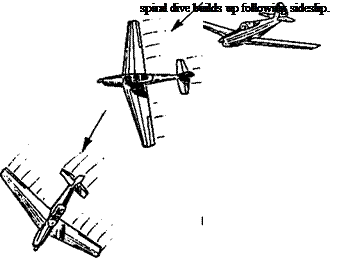12.27 SPIRAL INSTABILITY
Unfortunately, such a combination can lead to the converse of lateral instability, which is spiral instability. This arises if the fm area is too large relative to the dihedral. The initial small side-slip causes a strong weathercocking yaw. The dihedral, being slight, provides very small or no counter-rolling force, and the decrease of airspeed on the inner wing of the yaw causes that wing to drop. As mentioned in the next chapter, a similar effect arises when a model is yawed by means of the rudder control. With a spirally unstable model, the wing drop caused by the yaw is sufficiently sharp to increase the side-slip. The fin then attempts to weathercock the model further, and the wing drop again is too much and the sideslip continues, the bank angle increases and the model enters a turn which tends to tighten into a spiral. Since, as the angle of bank increases, the yaw relative to the ground becomes increasingly nose-down in direction, the spiral turn becomes a spiral dive at increasing airspeed, the bank angle approaches the vertical and the inertia loads on the wings rapidly multiply so that, if the model does not hit the ground first, the wings or tail are likely to break.
![]()
 |
Fig. 12.16 Spiral instability
High powered duration models are particularly prone to spiral instability since they are usually trimmed for a spiral climb and it is very easy for such a climb to become a spiral dive. To prevent this, fins are small and dihedral large, even at the cost of some Dutch rolling tendency. Free flight gliders generally, while less critical in this respect, tend in the same direction since while the Dutch roll is unpleasant and inefficient, it is comparatively safe, whereas the spiral dive invariably leads to a broken model. Radio controlled models, however, are usually spirally unstable to some extent As with full-sized aircraft, the early stages of a spiral dive are easily recognised and corrected, the dive does not build up immediately. As the nose begins to drop, a slight correction is given on the elevators, together with rudder and ailerons to check the yaw and roll. The Dutch roll, on the contrary, begins quite suddenly and, once started, is hard to stop because the pilot’s reactions are likely to be slow. It is even possible for the correcting control movements to be in phase with the oscillations, tending to increase them rather than damp them out The pilot recognises the yaw and roll a short time after they begin, and a moment later applies the controls to correct the condition. But by the time they take effect, the aircraft has already reached the limit of its swing in one direction, and the counter-movement in the other direction has begun. The pilot’s effort then helps only to make the next swing more violent, and when, after a momentary delay he realises this and moves the controls the other way, the aeroplane Ijas already passed through its maximum oscillation and again, the control movements make the condition worse. The pilot’s best hope is to centralise the controls and wait in the hope that the model has enough natural stability (i. e. enough fin area) to damp down the oscillation of its own accord. Another technique which often succeeds is to move the elevator control forward for a faster flight speed. This changes the wing lift coefficient and hence the forces at work may be damped.
The designer’s difficulties are increased by the fact that a model which is both spirally and laterally stable at one airspeed will not be so at all speeds. At high angles of attack spiral stability is very difficult to achieve. It requires generous dihedral on the wing, and quite small fin area, as on ‘duration’ models. At high speeds, however, the dihedral is too much and there is a tendency for such models to oscillate from side to side. The fin area needs to be larger to damp out oscillations. This tends to cause spiral instability. Fortunately, most models are designed mainly to fly at one speed, and a stable ‘one speed’ model is not impossible. For R. C. sailplanes, and powered duration models, which fly at varying speeds, there is no solution for all conditions. If the model is primarily a thermal soarer which will spend most of its flight time circling, effort should be concentrated on spiral stability – large dihedral with smallish fin. This will usually mean some tendency to wander and swing from side to side during ‘penetration’ glides or climb under power at high speeds. For the hill-soarer, long periods of circling flight are unusual, so spiral stability is less important. The fin area may be increased and dihedral reduced. Turns can be controlled carefully to check the tendency to develop a spiral dive. If control is by rudder only, however, dihedral must be quite large.











